|
Thursday, Nov. 15
1 p.m.
ILC ALCPG Physics and Detector R&D Seminar - WH-10NW, West Wing
Speaker: C. Gatto, INFN, Lecce
Title: Status of the Simulations in ILCroot
2:30 p.m.
Theoretical Physics Seminar - Curia II
Speaker: A. Petrov, Wayne State University
Title: Charm Mixing in the Standard Model and Beyond
3:30 p.m.
DIRECTOR'S COFFEE BREAK - 2nd Flr X-Over
4 p.m.
Accelerator Physics and Technology Seminar - One West
Speaker: S. Kazakov, KEK
Title: High-Power RF Sources and Components for Linear Colliders
Friday, Nov. 16
8:30 a.m. - 8 p.m.
Project X Workshop on Physics
3:30 p.m.
DIRECTOR'S COFFEE BREAK - 2nd Flr X-Over
4 p.m.
Joint Experimental-Theoretical Physics Seminar - One West
Speaker: M. Mangano, CERN
Title: Answering the Great Questions by Energy and Intensity Frontier
8 p.m.
Fermilab Lecture Series - Auditorium
Tickets: $5
Speaker: Dr. Dan Hooper, Fermilab
Title: In Search of Our Universe's Missing Mass and Energy
Click here for NALCAL,
a weekly calendar with links to additional information.
|
Thursday, Nov. 15
- Minnesota wild rice w/chicken
- Tuna melt on nine grain
- BBQ ribs
- Chicken casserole
- Vegetarian salad wrap
- Assorted slice pizza
- Mandarin chicken
Wilson Hall Cafe menu |
|
Thursday, Nov. 15
Dinner
- Curried butternut soup
- Spiced rubbed duck w/port wine sauce
- Corn risotto w/tomato and basil
- Rum raisin soufflé
Wednesday, Nov. 21
Lunch
- Cheese fondue
- Apple & pecan salad on field greens
- Baked pears w/bittersweet chocolate sauce
Chez Leon menu
Call x4598 to make your reservation. |
|
|
|
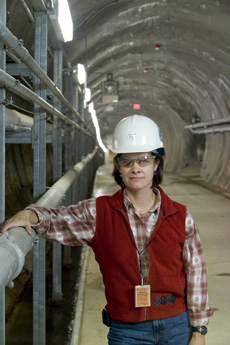
Nancy Grossman -- Associate project manager for NOvA
"We broke new ES&H ground in many areas on NuMI/MINOS. We had to work as a team, physicists and ES&H staff, to find creative, realistic solutions. It was a difficult but exhilarating experience."
See all Fermilab Profiles in Safety here.
|
Snapshot of the future from the floor of SC07
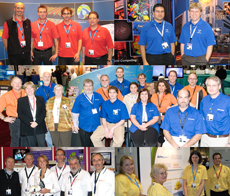
Congratulations to the dedicated teams who have gathered at SC07 from universities and institutions across the globe to present their grid technologies to the rest of the cutting edge IT world.
Images courtesy of iSGTW and John Urish
Three hundred and fourteen exhibitors, more than 9000 attendees, over a billion dollars in equipment, and a collection of the world's fastest, newest, most innovative and futuristic information technologies: welcome to Supercomputing 2007.
Buzzing with discussions, demonstrations and the blaze of super-sized LCD screens, the exhibition floor is home to everyone who's anyone in high performance computing.
To one side of this massive mini-city is a fleet of undergraduate student teams, working around the clock in a race to build a cluster powerful enough to earn top billing in the inaugural SC07 Cluster Challenge.
Read More
-- Cristy Burne, iSGTW
|
Calm reflection
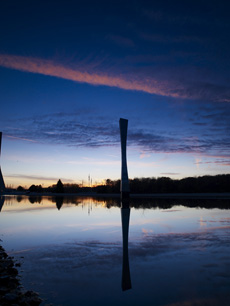
A photo taken at sunset of the Acqua Alle Funi sculpture, also known as the hyperbolic obelisk, shows a reflection of the sculpture in the pond. Image courtesy of Reidar Hahn.
|
Seeking the 'God particle'
From National Post, Nov. 12, 2007
WATERLOO -By making two lame jokes about the cold weather and a funnier one about stupid Americans, an eminent British particle physicist was clearly playing to his university-town crowd at a public lecture last week, about the biggest experiment in the history of science.
It was a significant crowd, nearly 600 people, packed to bursting into a high school auditorium because the nearby Perimeter Institute for Theoretical Physics, the $100-million clubhouse for Canada's top brainiacs, simply could not contain them.
These people, many bearded, mostly men, had gathered to see John Ellis, 61, the former head of the theory division at the European Organization for Nuclear Research (CERN). They were there to learn about Canada's role in ATLAS, the largest of four unprecedented experiments at CERN's Large Hadron Collider, a 27-kilometre-long circular tube buried 100 metres beneath the Swiss-French border near Geneva, lined with superconducting magnets that can accelerate a beam of particles to just shy of the speed of light.
Read More
|
Relativity passes new test of time
From Physicsworld.com, Nov. 14, 2007
Einstein's famous tenet of special relativity - that time slows down on a moving clock - has been verified 10 times more precisely than ever before. The result comes from physicists in Germany and Canada, who have timed the "ticking" of lithium ions as they hurtle around a ring at a fraction of the speed of light.
Sit two clocks side by side and, if they are accurate, they will always show the same time. But if one clock is moving rapidly, it will appear to an observer standing next to the stationary clock to be ticking too slowly. This "time dilation" effect, which was predicted by Einstein in his special theory of relativity in 1905, has been verified many times - first to within 1% of predictions in an experiment by Herbert Ives and G R Stilwell in 1938, and more recently by comparing the times of atomic clocks on Earth with those of orbiting global-positioning-system (GPS) satellites.
Such measurements haven't stopped scientists from suggesting deviations from special relativity, however. For instance, those that are looking for explanations why there is much more matter than antimatter in the universe often invoke a violation of "CPT theorem", which says that the laws of physics remain the same if the charge, parity and time-reversal properties of a particle are inverted together. CPT violation can justify the observed excess of normal matter, but it might also imply the equations underlying the Standard Model of particle physics, which are based on special relativity, are incomplete.
Read More
|
|
|
A charming challenger in a beautiful race
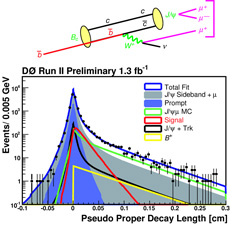
Top: A schematic of Bc meson decays examined in this analysis;
Bottom: distribution of proper decay lengths of candidates and a fit for decay lengths for signal and backgrounds where the transverse momentum of the three-muon system is used to estimate the relativistic lifetime boost factor for each candidate. The signal (red line) clearly shows a shorter lifetime than the background primarily due to the other longer-lived b hadrons (green line).
The family of b hadrons has a reputation for being slow; strolling along before they ultimately decay. Being bound states of a beauty quark and an antiquark (mesons) or of a beauty quark and two quarks (baryons), the B hadron lifetimes are determined by how quickly the heavy beauty quark decays. But when the companion quark is also heavy, the race is on to see who decays first. To catch a glimpse of this competition, physicists at the DZero experiment have snatched up front row seats to watch beauty and charm quarks race to decay within the Bc meson.
Decays of b hadrons are generally facilitated by the weak force, giving them long lifetimes. Due to the presence of a second quickly decaying heavy quark, the Bc meson's lifetime is roughly three times smaller than other B mesons. By making a precise measurement of the Bc lifetime, physicists can more clearly understand how the two quarks bound inside the meson interact in such close quarters.
To view this charm/beauty race, DZero physicists search for a Bc meson decaying to a J/psi (two bound charm quarks) and an additional muon plus neutrino. With the J/psi itself decaying to two muons, a tri-muon final state is the key signature sought by the team. Utilizing DZero's large muon acceptance, they analyze the invariant tri-muon mass to isolate the Bc meson decays. By performing a simultaneous fit to the tri-muon mass spectrum and a measurement of the distance the Bc traveled transverse to the proton-antiproton beam direction, the Bc lifetime can be distinguished from slower, longer-lived family members.
In 1.35 inverse femtobarns of data, DZero researchers have measured the Bc meson lifetime to be 0.44 +/- 0.04 (stat) +/- 0.04 (syst) picoseconds (10-12 seconds). This is the most precise measurement in the world and agrees well with the current theoretical prediction of 0.48 +/- 0.05 picoseconds. Though the initial results are in, the DZero researchers will be on the edge of their front-row seats watching this race go on as the Tevatron continues to bring charm and beauty together.
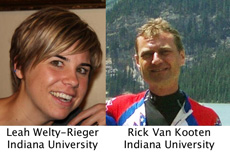
Leah Welty-Rieger and Rick Van Kooten made primary contributions to this analysis.
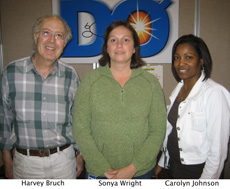
The DZero department's administrative support staff help keep the experiment's wheels turning via services such as procard orders, purchase requisitions, mail sorting, maintaining stock and office infrastructure, as well as supporting guests and assisting visitors all in addition to their department support responsibilities.
Result of the Week Archive
|
|
Have a safe day!
Benefit enrollment
Your opportunity to review and change your benefits for the 2008 plan year is now through Wednesday, Nov. 28.
You will find enrollment materials on the Benefits Office Web site. Representatives from Blue Cross and CIGNA will be available on Wednesday, Nov. 14, from 8 a.m. to noon and Tuesday, Nov. 20, from 1 to 5 p.m. They will be located in the Aquarium Conference Room on the 15th floor of Wilson Hall.
Project X physics workshop Nov. 16-17
Fermilab will host a users' workshop Nov. 16-17 to discuss the physics of Project X.
The group will meet at 8:30 a.m. Friday, Nov. 16, in Ramsey Auditorium. A wine and cheese talk by Michelangelo Mangano runs from 4 to 5:30 p.m. The Saturday session will be partly in One West, but also will include parallel sessions in different rooms. Streaming video of the sessions will be provided.
The agenda can be found here.
You should register if you plan to attend in person or via streaming video. Online registration is available.
Secure Coding course Jan. 15 and 16
This course focuses on Web applications and clearly defines the software security problem. It introduces and describes a set of software security best practices called touchpoints and much more. Learn more and enroll
Habitat restoration Saturday
Please join the Habitat Restoration group on Saturday, Nov. 17 at 9 a.m.
in the Lederman Science Center parking lot for coffee and doughnuts. From
there we will go to the area where we will cut down non-native plants. Please dress for the weather and bring gardening gloves.
For more information contact Barb Kristen or Rachel
Bridger. In the case of inclement weather please call the Fermilab operator to check for cancellation.
Additional Activities |
|